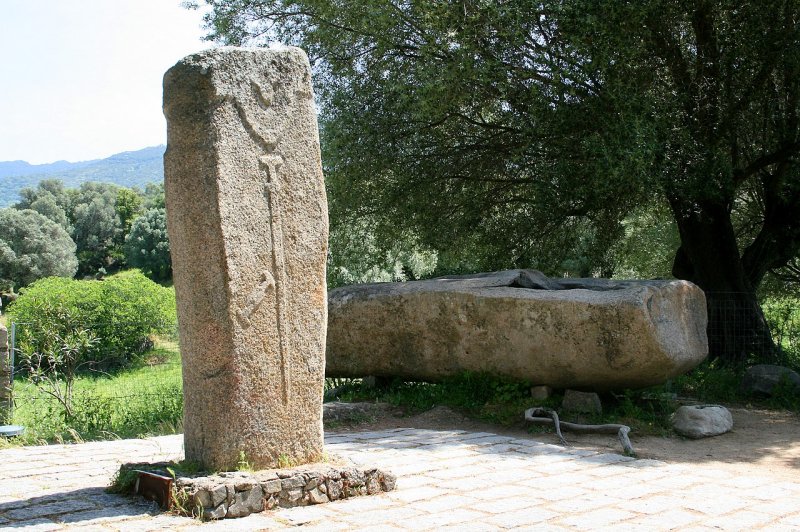Unique Balchiria Stelae Engraved With A Goat-Like Figure Found On Corsica Is A Puzzle
Jan Bartek – AncientPages.com - About 6,000 years ago, someone carved a mysterious goat-like figure on the Balchiria Stelae in Corsica.
It's a design unlike anything seen in the Western Mediterranean at this time. What were ancient people trying to tell us when they made this puzzling engraving? Who does it depict?
Left: Engraved Balchiria stela. Credit: F. Leandri - Right: Engraved stela drawing. Credit: R. Picavet
Corsica is an ethnically Italian island that has belonged to France since 1768, but there is archaeological evidence this beautiful place has been occupied for thousands of years.
Many ancient structures found on Corsica are mysterious, and so is even the island's name. It's unknown why the island is called Corsica. Perhaps the name comes from ancient Greece, where the island was known as Kalliste, Corsis, Cyrnos, Cernealis, or Cirné.
Corsica Was Occupied By Many Ancient Civilizations
During its long prehistory, Corsica has experienced many invasions and all ancient civilizations have left a legacy on the island. Phoenicians established numerous colonial cities along the coasts of the Mediterranean, and Carthaginians occupied Corsica for a short period. Later, Etruscans made claims on the land, and in 238 B.C. Corsica became a province of the Roman Republic.
Filitosa (Corse-du-Sud), France, the menhir Filitosa V. Image credit: Jean-Pol GRANDMONT - CC BY 3.0
During the Middle Ages, Corsica was invaded by the Vandals and the Ostrogoths, but the Byzantine Empire recovered the island and it became part of the Kingdom of the Lombards.
Struggles to claim Corsica as its own continued for many years, and so did attempts to gain independence. Finally, Corsica fell into the hands of the French.
Mysterious Ancient Structures On Corsica
There are many interesting ancient structures on Corsica that have intrigued archaeologists and historians. The most famous ones are known as the torri, "towers" named after their builders the Torrean civilization of the Corsican Bronze Age. These towers were raised in various parts of the island.
Prehistoric structures at Filitosa. Credit: xtra, CC BY-SA 2.0
The Torreans were stone warriors, who, according to researchers "were the same people as the seagoing Shardana who were known to have attacked Egypt in the late second millennium BC, and the bronze weapons with which they subdued the islanders were the weapons depicted on the sword-bearing menhirs of Filitosa." 1
The Torréens conquered Filitosa around 1300 BC and destroyed most of the menhirs, incorporating the broken stones into the area of dry-stone walling surrounding the site's tree torri (towers). Conical structures such as these were built by the Torréens all over the south of Corsica.
Anthropomorphic menhir in Tavera, Corsica. Credit: Filitosa Anthropomorphel, CC BY-SA 3.0
Again, no one is absolutely certain of their function; it's generally agreed that the smaller specimens are likely to have been used as places of worship to some divinity, though traces of ashes and bones found in some suggest they could have been where the Torréens burned of buried their dead. Corsica's larger torri are thought to have served as stores for weapons or food, or perhaps refuges or lookout towers." 2
The torris are similar to the Nuraghi which are beehive-like towers found on Sardinia.
Mystery Of The Balchiria Stelae
The two stone stelae, known as the Balchiria stelae were accidentally discovered in 2017. Scientists think it was once part of a now ruined prehistoric monument. The engraved anthropomorphic image of a goat-like figure has intrigued researchers.
"The head of the figure, which features a T-shaped block forming eyebrows and a nose, is capped by two curved appendages that resemble horns (Figure 1). The torso rests above a large circle, which features no explicit representation of lower limbs. The upper limbs are clearly depicted except at their extremities: the right limb is folded into a prayer position, while the left has been depicted only above the elbow." 3
Engraved stela morpho-technological study Credit:E. Mens
Ancient depictions of beings with horns have been found on many occasions in Europe. Archaeologists have uncovered more than one hundred rock-cut tombs in Sardinia that had walls covered with bucrania (schematic depictions of cattle head and horns). Several such engravings have been discovered in the hypogea of the Ozieri Culture (c. 4200–3500 BC) who also produced ceramics with outstretched arms. These ancient images have been interpreted as representations of a bull-like divinity.
However, the figure engraved on the does not resemble a bull, but rather a goat.
The presence of Ozieri influences in southern Corsica has been confirmed and it's possible the engraved stela at Balchiria could be the work of this ancient culture. However, the identity and purpose of the engraved goat-like figure are still open for debate.
The stela is unique in the Western Mediterranean context both in terms of its motif and morphology. Unraveling the mystery of Balchiria horned figure can tell us more about Sardinia's prehistory including peoples' ancient beliefs and traditions.
Updated on October 21, 2023
Written by Jan Bartek - AncientPages.com Staff Writer
Copyright © AncientPages.com All rights reserved. This material may not be published, broadcast, rewritten or redistributed in whole or part without the express written permission of AncientPages.com
Expand for references- Edward Gibbon - The History of the Decline and Fall of the Roman Empire
- Rough Guidesi - The Rough Guide to Corsica
- Guilaine, J., Leandri, F., Mens, E., & Picavet, R. (n.d.). The Balchiria stelae. Antiquity, 1-9. doi:10.15184/aqy.2019.228
- Palmer, Robert R. "The Kingdom of Corsica and the Science of History." Proceedings of the American Philosophical Society105, no. 4 (1961): 354-60. Accessed February 2, 2020.
- Robin, G. (2017). What Are Bucrania Doing in Tombs? Art and Agency in Neolithic Sardinia and Traditional South-East Asia. European Journal of Archaeology, 20(4), 603-635. doi:10.1017/eaa.2017.12
More From Ancient Pages
-
 2,000-Year-Old Historical Tombs Unearthed In Close Vicinity To Ancient City Of Laodicea
Archaeology | Jan 23, 2020
2,000-Year-Old Historical Tombs Unearthed In Close Vicinity To Ancient City Of Laodicea
Archaeology | Jan 23, 2020 -
 Old Unexplained Mystery Of The Frightening Woman On The Isle Of Iona
Featured Stories | Mar 8, 2024
Old Unexplained Mystery Of The Frightening Woman On The Isle Of Iona
Featured Stories | Mar 8, 2024 -
 New Evidence Of The Destruction Of The Second Temple In The City Of David
Archaeology | Aug 5, 2023
New Evidence Of The Destruction Of The Second Temple In The City Of David
Archaeology | Aug 5, 2023 -
 Link Between Changes In Evolution And Climate Discovered
Archaeology | Oct 4, 2022
Link Between Changes In Evolution And Climate Discovered
Archaeology | Oct 4, 2022 -
 Shield Maiden Freydis Eiriksdottir – Hot-Tempered Daughter Of Erik The Red Terrified Native Americans
Featured Stories | Dec 4, 2017
Shield Maiden Freydis Eiriksdottir – Hot-Tempered Daughter Of Erik The Red Terrified Native Americans
Featured Stories | Dec 4, 2017 -
 Europol Reports: ‘Millions’ In Stolen Treasures After Busting Crime Gang In Bulgaria – Recovered
Archaeology | Jul 4, 2020
Europol Reports: ‘Millions’ In Stolen Treasures After Busting Crime Gang In Bulgaria – Recovered
Archaeology | Jul 4, 2020 -
 New Unique Ancient Underwater Finds In The Ports Of Caesarea And Acre
Archaeology | Aug 11, 2021
New Unique Ancient Underwater Finds In The Ports Of Caesarea And Acre
Archaeology | Aug 11, 2021 -
 Vikings May Have Made Imitation Gold Dinar Found In Morston, Norfolk – Expert Says
Archaeology | Apr 5, 2023
Vikings May Have Made Imitation Gold Dinar Found In Morston, Norfolk – Expert Says
Archaeology | Apr 5, 2023 -
 Medieval Well-Preserved Sword Discovered In A Peat Bog In Poland
Archaeology | Jun 21, 2017
Medieval Well-Preserved Sword Discovered In A Peat Bog In Poland
Archaeology | Jun 21, 2017 -
 Beware Of The Night Marchers – Deadly Ghosts Of Warriors Who Kill With Just One Look
Featured Stories | Jul 23, 2019
Beware Of The Night Marchers – Deadly Ghosts Of Warriors Who Kill With Just One Look
Featured Stories | Jul 23, 2019 -
 New Images From The Magnificent Dendera Temple Where Restoration Works Continue
News | Mar 15, 2022
New Images From The Magnificent Dendera Temple Where Restoration Works Continue
News | Mar 15, 2022 -
 Did Ancient Romans Use Four-Meter Deep Shafts As Refrigerators During Summer?
Archaeology | Apr 6, 2018
Did Ancient Romans Use Four-Meter Deep Shafts As Refrigerators During Summer?
Archaeology | Apr 6, 2018 -
 Ancient Manuscripts Of Mythical City Of Timbuktu
Artifacts | Jun 12, 2014
Ancient Manuscripts Of Mythical City Of Timbuktu
Artifacts | Jun 12, 2014 -
 A Tooth That Rewrites History? The Discovery Challenging What We Knew About Neanderthals
DNA | Oct 23, 2023
A Tooth That Rewrites History? The Discovery Challenging What We Knew About Neanderthals
DNA | Oct 23, 2023 -
 Long-Lost Artifact Re-Discovered In Michigan Offers Evidence Of Overseas Visitors In Pre-Columbian Times
Legends And Mysteries Of North America | Jul 16, 2024
Long-Lost Artifact Re-Discovered In Michigan Offers Evidence Of Overseas Visitors In Pre-Columbian Times
Legends And Mysteries Of North America | Jul 16, 2024 -
 13 Ancient Terracotta Figurines Associated With Cybele And Attis Unearthed In Pompeii
Archaeology | Dec 28, 2023
13 Ancient Terracotta Figurines Associated With Cybele And Attis Unearthed In Pompeii
Archaeology | Dec 28, 2023 -
 Yak Milk Consumption Among Mongol Empire Elites – New Study
Archaeology | Apr 1, 2023
Yak Milk Consumption Among Mongol Empire Elites – New Study
Archaeology | Apr 1, 2023 -
 Huge 7,000-Year-Old Man-Made Structures Used For Religious Rituals Spotted In Poland
Archaeology | Nov 30, 2019
Huge 7,000-Year-Old Man-Made Structures Used For Religious Rituals Spotted In Poland
Archaeology | Nov 30, 2019 -
 Sator Square: Mysterious Ancient Magical Word Puzzle Remains Unsolved
Ancient Symbols | Apr 18, 2018
Sator Square: Mysterious Ancient Magical Word Puzzle Remains Unsolved
Ancient Symbols | Apr 18, 2018 -
 Controversial Ancient Book Of Veles Remains An Unexplained Mystery
Artifacts | Sep 28, 2015
Controversial Ancient Book Of Veles Remains An Unexplained Mystery
Artifacts | Sep 28, 2015





